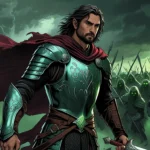“The Two Towers”, published in 1954, is the second volume of J.R.R. Tolkien’s epic fantasy trilogy, The Lord of the Rings. It continues the story of the Fellowship of the Ring as their paths diverge, dealing with themes of friendship, sacrifice, and the battle between good and evil. The narrative unfolds in two parallel arcs, following Aragorn, Legolas, and Gimli in their pursuit of Merry and Pippin, and Frodo and Sam’s perilous journey towards Mordor.
Plot Summary
Under the shadow of distant mountains, the great horn of Boromir shattered the air. The company was broken. On a blood-soaked field near the River Anduin, Boromir lay among the bodies of countless orcs, arrows piercing his strong frame. His final words charged Aragorn with protecting Gondor, but grief weighed heavily on the ranger, Legolas the elf, and Gimli the dwarf. Their fellowship shattered, the three resolved to pursue the orcs who had seized Merry and Pippin. Meanwhile, Frodo and Sam had slipped away, bearing the One Ring deeper into the treacherous lands of Mordor.
Aragorn, Legolas, and Gimli became tireless hunters, their swift feet tracing the brutal path of the Uruk-hai across the plains of Rohan. Their pursuit brought them face-to-face with Éomer, a marshal of the Riders of Rohan, who revealed that his men had slaughtered the orcs but had found no trace of the hobbits. Hope faltered, but the three pressed on, tracking faint signs of Merry and Pippin’s escape. Their path led them into the shadowed forest of Fangorn, where they encountered a figure thought lost—Gandalf, now transformed into Gandalf the White. Reborn and stronger, he rallied them to a new purpose: the defense of Rohan against the corrupt wizard Saruman.
Meanwhile, Merry and Pippin, captives of the Uruk-hai, endured torment and fear. As their captors clashed with rival orcs, chaos erupted, and the hobbits seized their chance to flee. They stumbled into Fangorn Forest, where they met Treebeard, an ancient and mighty Ent. Wise and deliberate, Treebeard took the hobbits under his care. As they shared their tales, the Ents awakened to the threat Saruman posed to their forest. Their wrath stirred, and Treebeard called an Entmoot—a great gathering of his kin—to decide their course. Slow as stone, the Ents deliberated, but their anger burned bright. At last, their march began, shaking the ground as they stormed toward Isengard.
In Rohan, Gandalf led Aragorn, Legolas, and Gimli to Edoras, the seat of King Théoden. There they found a ruler diminished, his will sapped by the treachery of his counselor, Gríma Wormtongue, and the malice of Saruman. Gandalf broke Saruman’s hold, restoring Théoden’s strength and resolve. Though despair threatened to consume him, Théoden chose to lead his people to battle. At Helm’s Deep, a fortress nestled in the mountains, the forces of Rohan prepared for war against Saruman’s army of orcs and men.
Night fell, and the fortress stood against a tide of enemies. The battle was fierce and unrelenting, and hope wavered as the enemy breached the walls. But at dawn, Gandalf returned, leading a company of Rohirrim reinforcements who turned the tide. Saruman’s forces were routed, driven into the shadowed depths of the forest, where Treebeard and the Ents awaited. The storm of Fangorn’s wrath crushed the remnants of the invaders.
The victors pressed on to Isengard, where the Ents had already unleashed their fury. Saruman’s stronghold lay in ruin, its machinery and armies drowned by the waters the Ents had summoned. Merry and Pippin, now safe within Treebeard’s care, greeted their friends with joy. Yet Saruman himself remained, trapped in the tower of Orthanc. Gandalf sought parley, but the wizard’s pride and malice left him a prisoner of his own making. A mysterious orb—the palantír—was recovered from the tower, its power both a boon and a danger.
Far to the east, Frodo and Sam faced trials of their own. Their journey led them into the Dead Marshes, a haunting expanse where ghostly lights danced over the remains of long-forgotten battles. Guided by the wretched creature Gollum, they pressed on, though mistrust simmered between them and their guide. Yet Gollum, bound by his oath, led them past the Black Gate of Mordor, where entry seemed impossible.
The path turned southward, through Ithilien, where Frodo and Sam encountered Faramir, Boromir’s brother. Though wary of the Ring’s power, Faramir proved a wise and noble ally, offering aid without succumbing to temptation. Yet danger loomed. Gollum, driven by his dual nature, plotted betrayal. He led Frodo and Sam toward Cirith Ungol, a treacherous mountain pass guarded by a terror known only to him.
Darkness deepened as they entered the pass. In the labyrinthine tunnels of Cirith Ungol, Gollum’s treachery came to fruition. He lured them into the lair of Shelob, a monstrous spider who struck with venom and malice. Frodo fell, ensnared by Shelob’s sting, but Sam, wielding unexpected courage, battled the creature and drove her off. Believing Frodo dead, Sam took the Ring and resolved to continue the quest alone. Yet as orcs approached, he discovered Frodo was alive, though captured. Driven by loyalty and desperation, Sam steeled himself for a perilous rescue.
The paths of the Fellowship diverged, yet a single purpose bound them: to resist the encroaching shadow. The Ring’s burden grew heavier, the cost of the journey steeper, and the hope of victory more tenuous. Yet courage endured, and with it, the faint light of defiance against the encircling dark.
Main Characters
Frodo Baggins: The reluctant yet resolute bearer of the One Ring. Frodo’s internal struggles and determination define his journey, as he grapples with the growing influence of the Ring and the weight of his quest.
Samwise Gamgee: Frodo’s loyal companion. Sam’s unwavering dedication and earthy wisdom provide strength and support, making him a pivotal character in Frodo’s journey.
Aragorn (Strider): The rightful heir to the throne of Gondor, Aragorn emerges as a decisive leader, grappling with his responsibilities while pursuing the captured hobbits.
Legolas Greenleaf: The elven archer from Mirkwood, whose keen senses and camaraderie lend support to Aragorn’s group.
Gimli, son of Glóin: A sturdy dwarf with a fierce sense of honor, Gimli’s budding friendship with Legolas exemplifies the breaking of racial divides.
Merry (Meriadoc Brandybuck) and Pippin (Peregrin Took): Hobbits whose capture by Orcs leads to pivotal events in Fangorn Forest, including the awakening of the Ents.
Gandalf the White: Reborn after his fall in Moria, Gandalf returns with greater wisdom and power to guide the free peoples in their struggle against Sauron and Saruman.
Gollum/Sméagol: A tragic figure torn between his desire for the Ring and remnants of his former self, Gollum becomes both a guide and a threat to Frodo and Sam.
Saruman: Once a powerful wizard, Saruman’s betrayal and alliance with Sauron drive much of the conflict in Rohan and beyond.
Éomer and Éowyn: Members of Rohan’s royal family, who embody courage and resistance against Saruman’s forces.
Treebeard: The ancient Ent who aids Merry and Pippin and leads the Ents in their assault on Isengard, representing the power of nature against industrial corruption.
Theme
The Corruption of Power: The influence of the One Ring symbolizes the corrupting force of absolute power, affecting even the most well-intentioned characters.
Friendship and Loyalty: Bonds of fellowship, such as Sam and Frodo’s partnership, Aragorn’s leadership, and the growing bond between Legolas and Gimli, showcase the strength found in unity.
The Natural World vs. Industrialization: Saruman’s exploitation of Isengard contrasts with the Ents’ deep connection to nature, highlighting Tolkien’s environmental concerns.
Heroism in Ordinary People: The hobbits, though physically unimposing, exemplify courage and resilience, proving that even the smallest can shape the fate of the world.
Hope Amid Despair: Amid the darkness of war and destruction, moments of light and hope persist, symbolized by acts of kindness, bravery, and trust.
Writing Style and Tone
Tolkien’s writing in The Two Towers blends a high, mythic tone with detailed realism. He weaves an immersive world through vivid descriptions of landscapes, cultures, and languages. His use of archaic diction and poetic prose evokes an epic quality, aligning the narrative with ancient tales like Beowulf and The Odyssey.
The tone varies between solemnity and moments of levity, reflecting the balance between the story’s weighty themes and the warmth of its characters. Tolkien masterfully shifts perspectives, providing intimate character insights while maintaining the grandeur of an overarching epic. The intertwining of parallel storylines enhances suspense and keeps the reader engaged.
We hope this summary has sparked your interest and would appreciate you following Celsius 233 on social media:
There’s a treasure trove of other fascinating book summaries waiting for you. Check out our collection of stories that inspire, thrill, and provoke thought, just like this one by checking out the Book Shelf or the Library
Remember, while our summaries capture the essence, they can never replace the full experience of reading the book. If this summary intrigued you, consider diving into the complete story – buy the book and immerse yourself in the author’s original work.
If you want to request a book summary, click here.
When Saurabh is not working/watching football/reading books/traveling, you can reach him via Twitter/X, LinkedIn, or Threads
Restart reading!








